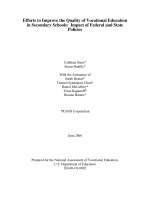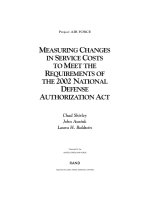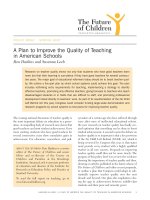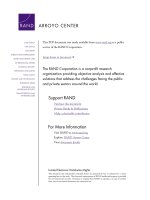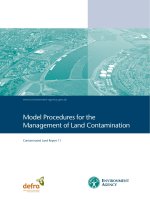A model to predict the function of hypothetical proteins through a nine-point classification scoring schema
Bạn đang xem bản rút gọn của tài liệu. Xem và tải ngay bản đầy đủ của tài liệu tại đây (1.01 MB, 8 trang )
Ijaq et al. BMC Bioinformatics
(2019) 20:14
/>
METHODOLOGY ARTICLE
Open Access
A model to predict the function of
hypothetical proteins through a nine-point
classification scoring schema
Johny Ijaq1,3, Girik Malik2,3,7, Anuj Kumar3,4 , Partha Sarathi Das3,5, Narendra Meena6, Neeraja Bethi1,
Vijayaraghava Seshadri Sundararajan3* and Prashanth Suravajhala3,6*
Abstract
Background: Hypothetical proteins [HP] are those that are predicted to be expressed in an organism, but no evidence
of their existence is known. In the recent past, annotation and curation efforts have helped overcome the challenge in
understanding their diverse functions. Techniques to decipher sequence-structure-function relationship, especially in
terms of functional modelling of the HPs have been developed by researchers, but using the features as classifiers for
HPs has not been attempted. With the rise in number of annotation strategies, next-generation sequencing methods
have provided further understanding the functions of HPs.
Results: In our previous work, we developed a six-point classification scoring schema with annotation pertaining to
protein family scores, orthology, protein interaction/association studies, bidirectional best BLAST hits, sorting signals,
known databases and visualizers which were used to validate protein interactions. In this study, we introduced three
more classifiers to our annotation system, viz. pseudogenes linked to HPs, homology modelling and non-coding RNAs
associated to HPs. We discuss the challenges and performance of these classifiers using machine learning heuristics
with an improved accuracy from Perceptron (81.08 to 97.67), Naive Bayes (54.05 to 96.67), Decision tree J48 (67.57 to
97.00), and SMO_npolyk (59.46 to 96.67).
Conclusion: With the introduction of three new classification features, the performance of the nine-point classification
scoring schema has an improved accuracy to functionally annotate the HPs.
Keywords: Hypothetical proteins, Machine learning, Classification features, Functional genomics
Background
Proteins that are predicted to be expressed from an open
reading frame, but for which there is no experimental evidence of translation are known as hypothetical proteins
(HPs). Across the whole genome, approximately 2% of the
genes code for proteins, while the remaining are
non-coding or still functionally unknown [1]. These
known-unknown regions for which no functional links are
discovered, i.e. those with no biochemical properties or
obvious relatives in protein and nucleic acid databases are
known as orphan genes, and the end products are called
HPs [2]. These proteins are of great importance, as many
of them might be associated with human diseases, thus
* Correspondence: ;
3
Bioclues.org, Kukatpally, Hyderabad 500072, India
Full list of author information is available at the end of the article
falling into functional families. Despite their lack of functional characterization, they play an important role in understanding biochemical and physiological pathways; for
example, in finding new structures and functions [3],
markers and pharmacological targets [4] and early detection and benefits for proteomic and genomic research [5].
In the recent past, many efficient approaches have existed
and the tools are publicly available to predict the function
of the HPs. One such widely used technique is
protein-protein interaction (PPI) analyses, which is considered valuable in interpreting the function of HPs [6].
While many proteins often interact with other proteins towards expediting their functions, there are challenges that
are not just limited to their function but also to their regulation [7]. Therefore, characterizing the uncharacterized
proteins helps to understand the biological architecture of
© The Author(s). 2019 Open Access This article is distributed under the terms of the Creative Commons Attribution 4.0
International License ( which permits unrestricted use, distribution, and
reproduction in any medium, provided you give appropriate credit to the original author(s) and the source, provide a link to
the Creative Commons license, and indicate if changes were made. The Creative Commons Public Domain Dedication waiver
( applies to the data made available in this article, unless otherwise stated.
Ijaq et al. BMC Bioinformatics
(2019) 20:14
the cell [8]. While high-throughput experimental methods
like the yeast two-hybrid (Y2H) method and mass spectrometry are available to discern the function of proteins,
the datasets generated by these methods tend to be incomplete and generate false positives [9]. Along with PPIs, there
are other methods to identify the essentiality of proteins,
such as antisense RNA [10], RNA interference [11],
single-gene deletions [12] and transposon mutagenesis [13].
However, all these approaches are tedious, expensive and
laborious; therefore, computational approaches combined
with high-throughput experimental datasets are required to
identify the function of proteins [9, 14]. Different computational methods have been designed for estimating protein
function based on the information generated from sequence similarity, subcellular localization, phylogenetic profiles, mRNA expression profiles, homology modelling etc.
[15]. Very recently, Lei et al. predicted essential proteins
based on RNA-Seq, subcellular localization and GO annotation datasets [16, 17]. Furthermore, tools such as “LOCALIZER” [18], that predicts subcellular localization of both
plant and effector proteins in the plant cell, and IncLocator
[19] have been useful in predicting subcellular localization
for long non-coding RNAs based on stacked ensemble classifiers [19]. On the other hand, combined analysis of all
these methods or datasets is considered to be more predictive in integrating heterogeneous biological datasets [9].
Genome-wide expression analysis, machine learning, data
mining, deep learning and Markov random fields are the
other prediction methods which are widely employed [20,
21], whereas Support Vector Machines (SVM) [22], Neural
Networks [23], Bayesian Networks [24, 25], Probabilistic
Decision Trees [26], Rosetta Stone [14, 27], Gene Clustering and Network Neighbourhood analyses [28] have been
used to combine different biological data sources to interpret biological relationships. Although these have shown to
be successful in predicting protein function, annotation
based on feature selection for inferring the function of HPs
is wanting. Nevertheless, there has been a steady increase
in the use of imparting machine learning and information
theoretic features used for development of efficient framework for predicting interactions between proteins [28–30].
In this paper, we present a machine learning based
approach to predict whether or not the given HP is functional. This method is not based on homology comparison
to experimentally verified essential genes, but depends on
the sequence-, topological- and Structure-based features that
correlate with protein essentiality at the gene level. Features
are the observable quantities that are given as input to a machine learning algorithm. Data given across each feature is
used by the learning algorithm to predict the output variables. Therefore, selecting the relevant features that could
predict the desired outputs is important. There are various
features that define the essentiality of the proteins. In our
previous study [31], we selected six such features (orthology
Page 2 of 8
mapping, back-to-back orthology, domain analysis, sorting
signals and sub-cellular localization, functional linkages, and
protein interactions) that are potentially viable to predict the
function of HPs. Although the prediction performance of
the selected features was shown to be acceptable, in this
present study we added data on pseudogenes, non-coding
RNA and homology modelling to increase the predictability
of functionality of these known-unknowns. The additional
features which we employed are extended to show the possibility of pseudogenes linked to HPs, proteins that are essentially structural ‘mers’ of the candidate proteins and presence
of non-coding RNA signatures. We discuss the performance
of newly introduced classification features from a machine
learning perspective to validate the function of HPs.
Results
We report the improved classification efficiency when
three additional features were introduced (Table 1) to our
earlier proposed six-point classification scoring schema.
When we analysed the data through 10-fold cross-validation using the WEKA machine learning package, the decision trees (J48) yielded an accuracy of 97%, with SVM
(SMO) performing high: 98, 93, 96 for Poly, RBF, npolyk
kernals respectively; MLP (neural network perceptron)
with 97.67% and Naive Baiyes multinomial with 98.33%
(Table 2). Among the classifiers that we evaluated using
WEKA, neural networks yielded the best performance with
a steady change in performance of the model. In addition,
one-way ANOVA with significance level (α) of 0.05 was
performed to ascertain the statistical significance of the
mean differences across the columns or groups based on
the p-value. The results were found to be statistically significant and in agreement with p-value heuristics (positive
and negative p-value of 3.166E-290 and 0, respectively). To
check the similarity and diversity of the samples, Jaccard
index similarity coefficient was plotted, providing different
values ranging from perfect similarity (value 1) to low similarity (threshold value). This was further augmented when
we compared the HPs from underlying similarity/distance
matrix scores for evaluation. Furthermore, Jaccard index
statistics revealed that the HPs annotated are inferential
with the first six classifiers, but the newly introduced classifiers tend to fall apart with the introduction of
non-coding elements (more details in Additional file 1:
Figure S2). Secondly, the negative dataset, which we call a
discrete dataset, is in principle a list of all known proteins
from GenBank falling under important types of HPs. The
194 proteins are probably scaled to only these types, generating bias with the rest of the features. Thus, we argue that
the negative dataset was largely more discrete and would
have a more stringent heuristic learning set. To further
check the redundancy, a pocket variant of perceptron algorithm was used as a unit step function, starting with a random w’ (weight) vector of length 9, eta (positive scale
Ijaq et al. BMC Bioinformatics
(2019) 20:14
Page 3 of 8
Table 1 Description of annotation for the three newly introduced features
Feature
Principle
Scoring criteria
Result
Pseudogenes
linked to HPs
It is generally believed that the majority of HPs
are the products of pseudogenes. Follow-up of
BLAST: if the hits do not have starting codon
ATG across six reading frames, then it may be
assumed to be a pseudogene.
Predicted and synthetic sequences, sequences
with end-to-end alignment are ignored.
Sequences from Homo sapiens with
E- value less than zero are considered.
Sequences starting without
methionine and meeting all the
above criteria were given 1,
otherwise 0.
Homology
Modelling
As sequence-structure implies function, it is
possible to assign function to HP if we could
model the protein to find any interacting
domains.
Based on % identity between query
and PDB template
If there is more than 30%
similarity, score = 1, otherwise 0.
Non-coding
RNAs
associated to
HPs
Most of the HPs from GenBank lack protein
coding capacity and some of them may
themselves be noncoding RNAs
The top three hits are considered for sequences
from Homo sapiens, while the top five hits are
considered when there is no considerable
difference between scores.
If the above criterion is met,
score 1, otherwise 0.
factor) as 0.2 and n as 1000. Invariably, perceptron gave
better validation across all classifiers. For example, with a
random split of 66% for the training and testing set, after
1000 iterations we obtained an average accuracy of 94.04%,
with a maximum 97.97% and a minimum of 60.60%. The
split performed was found to be random from all iterations, with no data point from the learning set being used
in the testing set. While the SVM yielded an average accuracy of 97.36%, with a max of 100% and min of 88.13%,
Naive Bayes, on the other hand, gave an accuracy of
96.62%, with a max of 100% and a min of 88.13%.
Discussion
The statistical evaluation suggests that among the newly introduced classifiers, non-coding RNAs and pseudogene
features show considerable impact, indicating that most of
the HPs are either the products of pseudogenes or linked to
ncRNAs (Table 3). Among the other six features, functional
linkages, pfam and orthology are highly significant, indicating that annotating the HPs across these features would
predict the probable function of HPs (Table 3). Feature selection algorithms like Correlation-based Feature Selection
(CFS) and Principal Component Analysis (PCA) also
showed improved accuracy, whereas the accuracies on the
entire data (ALL) are highest among the three methods indicating the importance of all the nine features in model
generation (Table 4). In addition, we derived the best data
subsets from the nine features by selecting top scores from
all combinations with an ALL subset combination method
“1 2 4 6 7 9” by functions_mlp (98.33) and PCA selected
Table 2 Comparison of all accuracies of all features using multiple learning algorithms derived through WEKA (ver 3.8) with
additional 3 new features increasing accuracy of the model
Learning algorithms
Accuracy with all 9 features
Average accuracy
Accuracy with all 6 features
trees_j48
97.00
95.85
67.57
trees_DecisionStump
86.33
45.95
trees_RandomForest
98.00
70.27
trees_REPTree
98.00
43.24
HoeffdingTree
96.67
Not reported
trees_LMT
98.33
70.27
trees_RandomTree
96.67
functions_smo_PolyK
98.33
functions_smo_RBFK
93.00
24.32
functions_smo_npolyk
96.67
59.46
functions_smo_Puk
97.33
functions_RBFNetwork
96.67
functions_mlp
97.67
81.08
functions_VotedPerceptron
97.00
Not reported
bayes_nbay
96.67
bayes_NaiveBayesUpdateable
96.67
55.21
bayes_NaiveBayesMultinomial
93.00
Not reported
bayes_NaiveBayesMultinomialUpdateable
93.00
Not reported
67.57
96.33
78.38
Not reported
97.11
94.83
48.65
54.05
Ijaq et al. BMC Bioinformatics
(2019) 20:14
Page 4 of 8
Table 3 Ranking to show the impact of each feature (Rank 1: High impact, Rank 9: Less impact)
Features
Functions_ smo_npolyk
trees_ j48
bayes_ nbay
Functions_mlp
Rules NNge
Pfam
5
5
5
5
5
Orthology
4
4
4
4
4
Pro_intercations
6
6
6
6
9
Bidirectional_best_blast_hits
7
7
7
7
8
Subcellular_location
7
7
7
9
7
Functional_linkages
2
2
2
2
3
Pseudogenes
3
3
3
3
1
Homology modelling
7
7
7
7
6
Non-coding RNAs
1
1
1
1
2
data subset “1 2 3 4 5 6 7 8” by functions_smo_npolyk
(97.00) and trees_j48 (97.00) as the best accuracies
(Table 5).
Overall, the combined methods of feature selection provided ample evidence that all nine features are essential
for a model generation. Correlation analysis has further
allowed us to improve our classification feature selection
pairs which tend to be positive for pfam and orthology (1
& 2); sub-cellular location and functional linkages (5 & 6);
functional linkages and homology modelling (6 & 8) (detailed in Additional file 2). In addition, the two-tailed
p-values for the above-mentioned combinations (1 & 2; 5
& 6; 5 & 8) were much less than the correlation (R) values,
indicating that the association between those variables is
statistically significant. We further analysed the performance of our model using various performance evaluation
metrics which showed improved performance for the
nine-point schema (Table 6, Additional file 3).
Methods
Construction of datasets
Two datasets were prepared for this study, viz. positive
and negative datasets, with the former constituting the
HPs while the latter representing functional proteins.
The final dataset consisted of 106 positive instances and
194 negative instances of HPs. These proteins were considered from GenBank with keyword searches “Homo sapiens” AND “Hypothetical Proteins” and further filtered
with annotation across the tools (Additional file 4). The
negative dataset was used to override false positives,
thereby obtaining improved precision. Algorithms learn
the characteristics underlying the known functional proteins from the given negative dataset. They are also used
to validate the predicted results by making a comparison
with known functional proteins. Finally, scores from all
the nine classifiers were summed up to give total reliability score (TRS; Fig. 1).
Significance of the features
The six features from our earlier proposed six-point
classification scoring schema are pfam score, orthology
inference, functional linkages, back-to-back orthology,
subcellular location and protein associations taken from
known databases and visualizers [31]. Conservation is
one of the important features of essential proteins. Studies have proven that essential proteins evolve more
Table 4 Derived accuracies by learning algorithms with default parameters set by WEKA are listed above. Column 1 lists different
algorithms
Algorithms
ALL
Cfs
PCA
Earlier study [25]
Current study
Earlier study [25]
Current study
Earlier study [25]
Current study
Selected Features □
1,2,3,4,5,6
1,2,3,4,5,6,7,8,9
1256
1,2,3,6,7,9
1,2,3,4,5,6
1,2,3,4,5,6,7,8
bayes_NaiveBayesUpdateable
55.21
96.67
54.05
96.67
72.97
93.00
functions_smo_npolyk
59.46
96.67
54.05
96.00
51.35
97.00
rules_DecisionTable
48.65
96.00
54.05
96.00
70.27
92.33
functions_mlp
81.08
97.67
59.46
96.67
81.08
96.00
bayes_nbay
54.05
96.67
54.05
96.67
72.97
93.00
trees_j48
67.57
97.00
51.35
96.00
72.97
97.00
Average
97.39
96.26
94.53
Column 2 shows accuracies on the entire data through ten-fold cross-validation. Columns 3 and 4 show accuracies by different algorithms after applying feature
selection algorithms as per the column header (Cfs Correlation Feature Selection, PCA Principal Component Analysis). Cfs uses best fit method and PCA uses
Ranker method as set by WEKA
Ijaq et al. BMC Bioinformatics
(2019) 20:14
Page 5 of 8
Table 5 Subset evaluation. Accuracies by learning algorithms with default parameters set by WEKA and best data subset by
combination (Column 3) and Feature selection method (column 5) are listed above
Algorithms
Best combination Subsets
(from complete dataset)
Accuracy
Feature selection subsets
Accuracy
bayes_NaiveBayesUpdateable
1,6,7,9
96.67
Cfs 1,2,3,6,7,9
96.67
functions_smo_npolyk
1,2,4,6,7,9
98.00
PCA 1,2,3,4,5,6,7,8
97.00
rules_DecisionTable
6,7,9
96.00
Cfs 1,2,3,6,7,9
96.00
functions_mlp
1,2,4,6,7,9
98.33
Cfs 1,2,3,6,7,9
96.67
bayes_nbay
1,6,7,9
96.67
Cfs 1,2,3,6,7,9
96.67
trees_j48
1,2,4,6,9
97.67
PCA 1,2,3,4,5,6,7,8
97.00
Column 1 lists different algorithms. Columns 2 & 4 list the best data subsets and Columns 3 & 5 accuracies, respectively. (1: Pfam; 2: Orthology; 3:
Prot_interactions; 4: Best Blast hits; 5: Subcellular localization; 6: Functional linkages; 7: HPs linked to Pseudogenes 8: Homology modelling; 9: HPs linked to
ncRNAs). Accuracies shown by both the subset combinations are almost same, with subset combinations from the complete dataset showing a slightly
higher accuracy
find any interacting domains through structural
bioinformatics-based approaches [39]. Most of the HPs
from GenBank lack protein-coding capacity. Similarly,
non-coding RNAs by definition do not encode proteins.
This indicates that some of the HPs may themselves be
noncoding RNAs [40]. With this feature, we checked if
HPs are associated with non-coding RNAs and are influenced by regulatory regions (detailed in Table 1).
slowly and are more evolutionarily conserved than
non-essential proteins [32]. While we used sequencebased features like orthology, back-to-back orthology
and domain analysis to describe the essentiality of the
proteins from the perspective of evolutionary conservation [33], proteins often interact with each other to accomplish the biological functions of cells [34]. Apart
from this, functional linkages [35] and subcellular
localization [36] have been popular in predicting the essentiality or what we call the known-unknowns of proteins. Three new features that were considered in this
model are HPs linked to pseudogenes, homology modelling and HPs linked to non-coding RNAs. Pseudogenes
are the functionally deprecated sequences present in the
genome of an organism. These disabled copies of genes
are the products of gene duplication or retrotransposition of functional genes [37]. It is generally believed that
the majority of the HPs are the products of pseudogenes
[38]. This feature is employed to check if the HP is
actually a pseudogene by performing tBLASTn, a variant
of BLAST which considers proteins as a query and
searches against the nucleotide database. The homology
modelling feature was introduced to predict the essentiality of the protein based on the model generated. As
the protein three-dimensional (3D) structure leads to
function, there is a possibility to assign biological
function to proteins, if one could generate the model to
Classifier design and training
Prediction of the function of HPs can be presented as a
binary classification problem. Each protein from both
datasets was annotated across nine selected features and
assigned a score of 1 if the protein met the criteria or 0
if it did not (Fig. 2). Criteria followed for scoring are
shown in Additional file 5: Figure S1. The classifier was
trained across the nine features according to the scores
assigned to the members of each dataset. We used four
major classifiers to train and test the model: (i) SVM (ii)
Naïve Bayes (iii) Decision trees and (iv) Perceptron. For
non-separable learning sets, a variant of perceptron
called pocket algorithm [41] was used, which arbitrarily
minimizes the error for the non-separable learning set
[42]. It works by storing and using the best solution seen
so far rather than relying on the last solution. These solutions appear purely stochastic. 80% of the dataset was
used for training and the rest for testing. We performed
Table 6 Individual nine-point schema data are subjected through learning algorithms and scoring metrics are derived, averaged
and tabulated. Values are compared with the six-point performance metrics
Algorithm
Sensitivity/
Recall (%)
Specificity (%)
Precision (%)
F1 Score (%)
MCC (%)
Six
point
Nine
point
Six
point
Nine
point
Six
point
Nine
point
Six
point
Nine
point
Six
point
Nine
point
Decision Tree (j48)
37
38
90
93
17
85
23
41
16
54
SVM (functions_smo_npolyk)
36
37
89
93
16
57
22
41
15
36
Neural networks(functions_mlp)
36
38
89
92
16
80
22
43
15
53
Naïve Bayes (Bayes_Naïve
BayesUpdateable)
37
37
89
93
16
81
22
40
17
53
Ijaq et al. BMC Bioinformatics
(2019) 20:14
Fig. 1 Methodology adopted to generate the classification model
Fig. 2 Workflow to annotate HPs across each classifier (Details in Additional file 2: Figure S1)
Page 6 of 8
Ijaq et al. BMC Bioinformatics
(2019) 20:14
1000 independent iterations of SVM, Naïve Bayes and
Perceptron algorithms. Instead of a k-fold cross-validation, we considered 1000 independent iterations and
averaged their results so as to avoid over-fitting, assuming that a k for such a problem is beyond the scope of
this work. Further, we analysed the data using the Waikato Environment for Knowledge Analysis (WEKA) software package (version 3.8) [43] where 37 other learning
algorithms were used along with the aforementioned
four major algorithms. WEKA was implemented for
classifier design, training and evaluation. Finally, Jaccard
indices followed by training the datasets using machine
learning algorithms were used to infer heuristics.
Performance evaluation
Evaluating the performance of learning algorithms is a
central aspect of machine learning. Several measures including cross-validation as a standard method [44] and a
10-fold cross-validation using WEKA were applied to
test the performance of the predictive model. To mitigate the over-fitting problem, the following measures
were used to evaluate the performance of the classifiers:
accuracy, sensitivity, specificity, F1 score, Matthew’s
Correlation Coefficient (MCC) [45, 46]. Specificity, Precision, Sensitivity and MCC of 1 indicate perfect prediction accuracy [47].
The measures are defined as follows:
Accuracy = (TP + TN) / (TP + FN + FP + TN).
Sensitivity (Recall) = TP / (TP + FN).
Specificity = TN / (TN + FP).
Precision = TP / (TP + FP).
F1 Score = 2(Precision * Recall) / (Precision + Recall).
Matthews Correlation Coefficient (MCC).
= ((TP x TN) - (FP x FN)) / (TP + FP) (TP + FN)
(TN + FP) (TN + FN).
where TP: True Positives (positive samples classified
correctly as positive), TN: True Negatives (negative
samples classified correctly as negative), FP: False
Positives (negative samples predicted wrongly as
positive) and FN: False Negatives (positive samples predicted wrongly as negative).
Page 7 of 8
known-unknown regions. The potential regulatory function of HPs could be determined if there are larger curated datasets. However, this is also influenced by how
the HPs interact with each other, given a new set of dimensions in the form of next-generation sequencing to
the scientific community.
Additional files
Additional file 1: Figure S2. Jaccard index plot showing the coefficient
distances for the HPs. The x-axis indicates the HPs while the y-axis indicates
the distance. (XLSX 20 kb)
Additional file 2: Tables showing correlation analysis (XLSX 150 kb)
Additional file 3: Learning algorithms results (XLSX 11 kb)
Additional file 4: List of HPs which we used for classification and
machine learning approaches (XLSX 23 kb)
Additional file 5: Figure S1. Workflow adopted for annotation and
scoring of HPs across each classifier (PDF 249 kb)
Additional file 6: Performance evaluation (PDF 152 kb)
Abbreviations
BLAST: Basic local alignment search tool; HP: Hypothetical protein;
WEKA: Waikato environment for knowledge analysis
Acknowledgements
The authors gratefully acknowledge Gilda Kishinovsky for her kind asistance
in proofreading the manuscript. JI acknowledges the support of CSIR for
providing a research fellowship to pursue his Ph.D.
Funding
The work received no funding whatsoever.
Availability of data and materials
The data is available for public use in the form of Additional file 2 and 6.
Authors’ contributions
JI prepared the datasets and annotated the classifiers. AK annotated homology
modelling classifier. JI, VSS and PS curated the entries. JI, GM, VSS, NB and PS
wrote the first draft of the manuscript. GM and PSD worked on machine
learning heuristics, JI worked on performance evaluation and statistics,
NM worked on Jaccard indices, VSS cross-checked the machine learning
heuristics, PS and VSS proofread the manuscript. All authors have carefully read
the final manuscript before submission.
Ethics approval and consent to participate
Not applicable.
Consent for publication
Not applicable.
Competing interests
The authors declare no competing interests whatsoever.
Conclusion
We have proposed a nine-point classification scoring
schema to help functionally annotate the HPs. While a
large number of heuristics were interpreted to introduce
such problems, there is a strong need to ensure that the
HPs in question are provided a function in silico. An attempt has been made to close the gap of providing functional linkages to HPs. The addition of classification
features would possibly serve as a valuable resource for
analysing
data
and
for
understanding
the
Publisher’s Note
Springer Nature remains neutral with regard to jurisdictional claims in
published maps and institutional affiliations.
Author details
1
Department of Biotechnology, Osmania University, Hyderabad 500007, India.
2
Department of Pediatrics, The Battelle Center for Mathematical Medicine,
The Research Institute at Nationwide Children’s Hospital, The Ohio State
University, Columbus, OH, USA. 3Bioclues.org, Kukatpally, Hyderabad 500072,
India. 4Advanced Center for Computational and Applied Biotechnology,
Uttarakhand Council for Biotechnology, Dehradun 248007, India.
5
Department of Microbiology, Bioinformatics Infrastructure Facility,
Ijaq et al. BMC Bioinformatics
(2019) 20:14
Vidyasagar University, Midnapore, India. 6Department of Biotechnology and
Bioinformatics, Birla Institute of Scientific Research, Statue Circle, RJ 302001,
India. 7Labrynthe, New Delhi, India.
Received: 5 June 2018 Accepted: 30 November 2018
References
1. Uhlen M, et al. Towards a knowledge-based human protein atlas. Nat
Biotechnol. 2010;28(12):1248–50.
2. Galperin MY. Conserved ‘hypothetical’ proteins: new hints and new puzzles.
Comp Funct Genomics. 2001;2(1):14–8.
3. Nimrod G, et al. Detection of functionally important regions in “hypothetical
proteins” of known structure. Structure. 2008;16(12):1755–63.
4. Shahbaaz M, et al. Functional annotation of conserved hypothetical proteins
from Haemophilus influenzae Rd KW20. PLoS One. 2013;8(12):e84263.
5. Mohan R, Venugopal S. Computational structures and functional analysis
of hypothetical proteins of Staphylococcus aureus. Bioinformation. 2012;
8(15):722–8.
6. Murakami M, et al. InCeP: intracellular pathway based on mKIAA protein-protein
interactions. DNA Res. 2005;12(5):379–87.
7. Ijaq J, et al. Annotation and curation of uncharacterized proteins-challenges.
Front Genet. 2015;6:119.
8. Shoemaker BA, Panchenko AR. Deciphering protein–protein interactions.
Part I. Experimental techniques and databases. PLoS Comp Biol. 2007;
3(3):e42.
9. Zhang LV, et al. Predicting co-complexed protein pairs using genomic and
proteomic data integration. BMC Bioinformatics. 2004;5:38.
10. Ji Y, et al. Identification of critical staphylococcal genes using conditional
phenotypes generated by antisense RNA. Science. 2001;293(5538):2266–9.
11. Kamath RS, et al. Systematic functional analysis of the Caenorhabditis
elegans genome using RNAi. Nature. 2003;421(6920):231–7.
12. Giaever G, et al. Functional profiling of the Saccharomyces cerevisiae
genome. Nature. 2002;418(6896):387–91.
13. Gallagher LA, et al. A comprehensive transposon mutant library of
Francisella novicida, a bioweapon surrogate. Proc Natl Acad Sci. 2007;104(3):
1009–14.
14. Enright AJ, et al. Protein interaction maps for complete genomes based on
gene fusion events. Nature. 1999;402(6757):86–90.
15. Sivashankari S, Shanmughavel P. Functional annotation of hypothetical
proteins-a review. Bioinformation. 2006;1(8):335–8.
16. Lei X, et al. Predicting essential proteins based on RNA-Seq, subcellular
localization and GO annotation datasets. Knowl-Based Syst. 2018;151:136–47.
17. Li M, et al. Identifying essential proteins based on sub-network partition and
prioritization by integrating subcellular localization information. J Theor Biol.
2018;447:65–73.
18. Sperschneider J, et al. LOCALIZER: subcellular localization prediction of both
plant and effector proteins in the plant cell. Sci Rep. 2017;7:44598.
19. Zhen C, et al. The lncLocator: a subcellular localization predictor for long
non-coding RNAs based on a stacked ensemble classifier. Bioinformatics.
2018;34(13):2185–94.
20. Eisen MB, et al. Cluster analysis and display of genome-wide expression
patterns. Proc Natl Acad Sci U S A. 1998;95(25):14863–8.
21. Deng M, et al. Prediction of protein function using protein-protein
interaction data. J Comput Biol. 2003;10(6):947–60.
22. Bock JR, Gough DA. Predicting protein-protein interactions from primary
structure. Bioinformatics. 2001;17(5):455–60.
23. Fariselli P, et al. Prediction of protein--protein interaction sites in
heterocomplexes with neural networks. Eur J Biochem. 2002;269(5):1356–61.
24. Troyanskaya OG, et al. A Bayesian framework for combining heterogeneous
data sources for gene function prediction (in Saccharomyces cerevisiae). Proc
Natl Acad Sci U S A. 2003;100(14):8348–53.
25. Jansen R, et al. A Bayesian networks approach for predicting protein–protein
interactions from genomic data. Science. 2003;302(5644):449–53.
26. Chen XW, Liu M. Prediction of protein–protein interactions using random
decision forest framework. Bioinformatics. 2005;21(24):4394–400.
27. Marcotte EM, et al. Detecting protein function and protein–protein
interactions from genome sequences. Science. 1999;285(5428):751–3.
28. Nigatu D, Henkel W. Prediction of essential genes based on machine
learning and information theoretic features. Proceedings of BIOSTEC
2017 – BIOINFORMATICS; 2017. p. 81–92.
Page 8 of 8
29. Li M, et al. United complex centrality for identification of essential proteins
from PPI networks. IEEE/ACM Trans Comput Biol Bioinform. 2017;14(2):370–80.
30. You Z-H, et al. Highly efficient framework for predicting interactions
between proteins. IEEE Trans Cybern. 2017;47(3):731–43.
31. Suravajhala P, Sundararajan VS. A classification scoring schema to validate
protein interactors. Bioinformation. 2012;8(1):34–9.
32. Gustafson AM, et al. Towards the identification of essential genes using
targeted genome sequencing and comparative analysis. BMC Genomics.
2006;7:265.
33. Deng J, et al. Investigating the predictability of essential genes across
distantly related organisms using an integrative approach. Nucleic Acids
Res. 2010;39(3):795–807.
34. Peng W, et al. Iteration method for predicting essential proteins based
on orthology and protein-protein interaction networks. BMC Syst Biol.
2012;6:87.
35. Wang J, et al. Computational approaches to predicting essential proteins: a
survey. Proteomics Clin Appl. 2013;7(1–2):181–92.
36. Li G, et al. Predicting essential proteins based on subcellular localization,
orthology and PPI networks. BMC Bioinformatics. 2016;17(Suppl 8):279.
37. Mighell AJ, et al. Vertebrate pseudogenes. FEBS Lett. 2000;468(2–3):109–14.
38. Shidhi PR, et al. Identifying pseudogenes from hypothetical proteins for
making synthetic proteins. Syst Synth Biol. 2014;8(2):169–71.
39. França TC. Homology modeling: an important tool for the drug discovery. J
Biomol Struct Dyn. 2015;33(8):1780–93.
40. Jia H, et al. Genome-wide computational identification and manual
annotation of human long noncoding RNA genes. RNA. 2010;16(8):1478–87.
41. Gallant SI. Perceptron-based learning algorithms. IEEE Trans Neural Netw.
1990;1(2):179–91.
42. Muselli M. On the convergence properties of the pocket algorithm. IEEE
Trans Neural Netw. 1997;8(3):623–9.
43. Eibe Frank, et al. The WEKA Workbench. Online Appendix for “Data Mining:
Practical Machine Learning Tools and Techniques”, Morgan Kaufmann,
Fourth Edition, 2016.
44. Hu P, et al. Computational prediction of cancer-gene function. Nature Rev
Cancer. 2007;7(1):23–34.
45. Baldi P, et al. Assessing the accuracy of prediction algorithms for
classification: an overview. Bioinformatics. 2000;16(5):412–24.
46. Matthews BW. Comparison of the predicted and observed secondary
structure of T4 phage lysozyme. Biochim Biophys Acta. 1975;405(2):442–51.
47. Saito T, Rehmsmeier M. The precision-recall plot is more informative
than the ROC plot when evaluating binary classifiers on imbalanced
datasets. PLoS One. 2015;10(3):e0118432. />pone.0118432.
